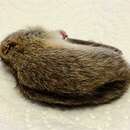en
names in breadcrumbs


Birch mice (genus Sicista) are small jumping rodents that resemble mice with long, tufted tails and very long hind legs, allowing for remarkable leaps. They are the only extant members of the family Sminthidae.[1] They are native to Eurasian forests and steppes. All variants possess a long tail of 65 to 110 mm (2.6 to 4.3 in) of length and weigh about 6 to 14 g (0.21 to 0.49 oz). Head and body length of 50 to 90 mm (2.0 to 3.5 in) and hind foot length of 14 to 18 mm (0.55 to 0.71 in).[2] The animal's skin color is light brown or dark-brown to brownish yellow on the upper side and paler on the underside, but generally brownish.[2] Birch mice have a vast geographic distribution in that they inhabit a wide variety of habitats, from semiarid areas to subalpine meadows.[3] Although they have a diverse region of areas, their molecular and anatomical markers have claimed that Birch mice originated from Central Asia.[4]Birch mice have a systematic of the genus of Sicista, they look at the male reproductive organs and cytogenic data.[5]
Nineteen species are listed by the American Society of Mammalogists as of 2021:[6]
All species of Sicista cluster into five major lineages: S. betulina, S. caucasica, S. caudata, S. tianschanica, and S. concolor.[7]
Birch mice (genus Sicista) are small jumping rodents that resemble mice with long, tufted tails and very long hind legs, allowing for remarkable leaps. They are the only extant members of the family Sminthidae. They are native to Eurasian forests and steppes. All variants possess a long tail of 65 to 110 mm (2.6 to 4.3 in) of length and weigh about 6 to 14 g (0.21 to 0.49 oz). Head and body length of 50 to 90 mm (2.0 to 3.5 in) and hind foot length of 14 to 18 mm (0.55 to 0.71 in). The animal's skin color is light brown or dark-brown to brownish yellow on the upper side and paler on the underside, but generally brownish. Birch mice have a vast geographic distribution in that they inhabit a wide variety of habitats, from semiarid areas to subalpine meadows. Although they have a diverse region of areas, their molecular and anatomical markers have claimed that Birch mice originated from Central Asia.Birch mice have a systematic of the genus of Sicista, they look at the male reproductive organs and cytogenic data.